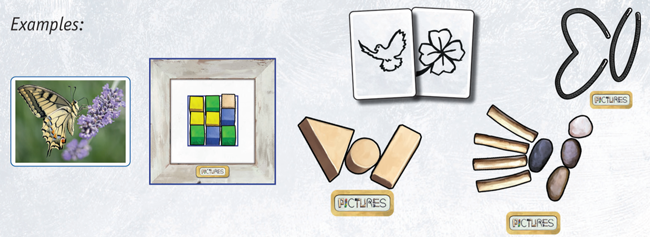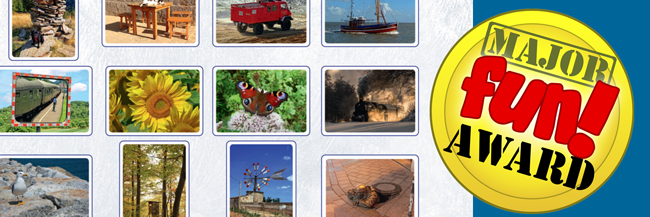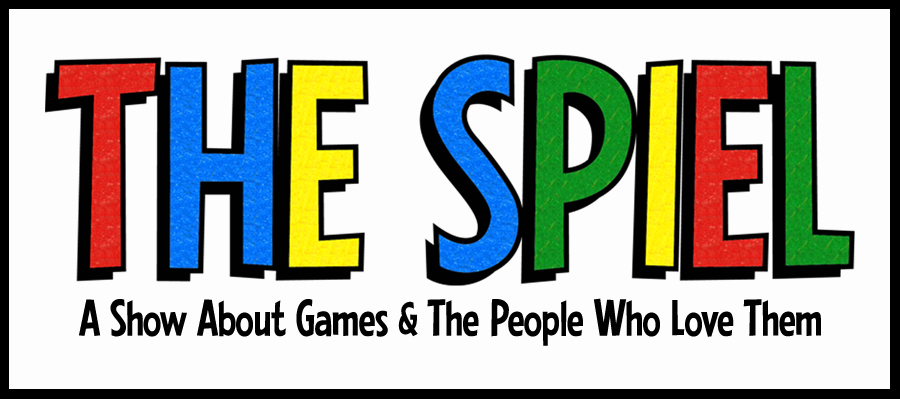Episode 348: Pictures

|
Release Date: Apr. 29, 2020 |
Download: PDF |
|
Designers: Daniela and Christian Stöhr |
Publisher: PD Verlag, Rio Grande Games |
|
3-5 players | 20-30 min | ages 8+ | 5 min to learn | $45 |
|
A game of Pictures starts with a simple premise: you don’t have to be the next Van Gogh or Kahlo to discover there’s a little artistry in each of us.
There’s no drawing or painting involved. Instead, you’ll use blocks and rocks and sticks and symbols and shoelaces and tiny colored cubes to create your version of a picture. Will others be able to find your picture when it’s hanging in a gallery with others?
Written review continues after the break.
Pictures PD Verlag | BGG | Buy

The Concept
A game of Pictures starts with a simple premise: you don’t have to be the next Van Gogh or Kahlo to discover there’s a little artistry in each of us.
There’s no drawing or painting involved. Instead, you’ll use blocks and rocks and sticks and symbols and shoelaces and tiny colored cubes to create your version of a picture. Will others be able to find your picture when it’s hanging in a gallery with others?
The Components
At first glance, Pictures might look like someone has emptied the random contents of a desk drawer into the box. There are five sets of art objects:
- 6 chunky wooden blocks in different shapes
- 24 colored wooden cubes with a frame card
- 19 icon cards
- a long shoelace and a short shoelace
- and a set of 4 sticks and 4 rocks (yes, actual rocks)
Along with this odd assortment, you’ll find a deck of 91 picture cards and a set of coordinate tokens with a drawstring bag. The picture cards run the gamut - animals, landscapes, objects, vehicles, wide vistas and close-ups.
To play, deal out 16 picture cards in a four by four grid. Place coordinate tokens along the rows and columns. Each player selects one of the sets of art materials and we’re ready to begin!

The Mechanics
Each turn has two phases in Pictures - a creating phase and a guessing phase. The creation phase begins with each player selecting a coordinate token from the bag. This token identifies which picture in the grid is yours. Keep this secret from everyone else. Now, you’re set. Try your best to make a representation of your picture using the art materials at your disposal. There are no restrictions on how you may use the materials with two exceptions:
- With the colored cubes, all the cubes must fit within the frame, meaning you may only use 9 of the 24 cubes in your picture.
- With the icon cards, you may only use 2-5 cards to represent your picture.
There’s no formal time limit to the creation phase. And don’t stress out if you need a moment to come up with a plan. This is not a game about making masterpieces. It’s a game about doing the best you can with what you’re given.

When all the creations are ready, the guessing phase begins. Look at all the other creations and note down on your scoresheet the picture coordinates that you think match each one. One by one, the artist will reveal the correct match. If you guessed correctly, you score a point and the artist scores one point for each correct guess.
Next round, shift each set of art materials to the another player. Play until each person has had a chance to use each set of materials. High score wins the game.
What Sets This Game Apart
Freedom and variety set Pictures apart.
You have the freedom to envision and use the materials in a variety of ways. With the blocks, you could stack them or arrange them in a diorama. With the shoelaces, you can create squiggly line drawings. The rocks and sticks could be a combination of any of these methods or something else entirely.

Your freedom extends to another important decision each round. You must decide what parts of the picture are the most important to depict. Given the crazy materials and their limited quantity, there’s no possible way for you to include every detail in any picture you see. Therefore, you have to make important decisions about what to include and what to leave out.
Each picture may have a focal piece but when put in context with the other pictures in the grid, that one item alone may not set it apart. So, the trick in Pictures is often deciding what smaller details to include.
Some rounds the picture and the materials may come together and an idea just leaps out at you. Others, you may be left laughing and scratching your head on what to do. You may develop favorites or grudges against certain sets of materials. But don’t worry. Any sets you struggle with initially, you can learn new methods by seeing how others use them.

This convergence of freedom and variety insures that every round of the game will be new and different. And because every round is so quick, each combination of picture and materials seems like an opportunity for fun, not an obstacle to it.
We certainly love the game as presented but we have added an extra layer of variety and freedom to our house rules that you might want to try as well. Instead of leaving the same cards in the grid each round, any card that was used is replaced. This means the grid of pictures changes each turn and prevents copycat artists from re-using the same depiction on a later round.
Final Thoughts
Pictures encourages creativity in unexpected ways. There’s no expectation of mastery and therefore no pressure to perform on a sophisticated level. Pictures may not include any paint brushes but it is a game about broad strokes. Can you, with the most basic of materials, somehow, some way, get people to see a more complex picture? The tools are simple. The gameplay is constantly challenging. And the fun and laughs that Pictures creates is pure Major Fun.
Written by: Stephen Conway
***

***
